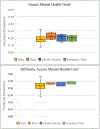State Differences in Children's Mental Health Care
- PMID: 39362631
- PMCID: PMC11897828
- DOI: 10.1016/j.acap.2024.09.009
State Differences in Children's Mental Health Care
Abstract
Objective: This study estimates and compares variation in the probability of child unmet need for mental health care and difficulties accessing care for each state in the United States. Estimates are also generated and compared for three socioeconomic and demographic subgroups nationwide: racial and ethnic group, household income, and insurance type.
Methods: Using a retrospective, cross-sectional design, this study pooled 2016-2019 National Survey of Children's Health data. National, state, and subgroup adjusted probabilities of caregiver-reported child unmet need for mental health care and ease of access to mental health care were generated from logistic regression models with marginal post-estimation.
Results: Adjusted national probabilities of caregiver-reported child unmet mental health need and difficulty in accessing care were 0.21 and 0.46, respectively. State probabilities of unmet need ranged from 0.08 to 0.32. One state was significantly above the national estimate; nine states were below it. State probabilities of difficulty accessing mental health care ranged from 0.28 to 0.57; nine states' probabilities were significantly below the national estimate and two states were significantly above it. Estimates of unmet mental health need and difficulty accessing care varied more widely across states than across racial or ethnic groups, income groups, insurance groups.
Conclusions: Geographic inequities in children's mental health care access persist; in some cases, they are larger than sociodemographic inequities.
Keywords: access to mental health care; child mental health; geographic disparities; unmet mental health care need.
Copyright © 2025 Academic Pediatric Association. Published by Elsevier Inc. All rights reserved.
Conflict of interest statement
Declaration of Competing Interest The authors declare the following financial interests/personal relationships which may be considered as potential competing interests: Genevieve Graaf reports financial support was provided by National Institute of Mental Health. Phillip Hughes reports financial support was provided by Agency for Healthcare Research and Quality.
Figures


References
-
- Urdapilleta O, Kim G, Wang Y, et al. National Evaluation of the Medicaid Demonstration Waiver Home- and Community-Based Alternatives to Psychiatric Residential Treatment Facilities. Submitted to Disabled and Elderly Health Programs Group Centers for Medicare and Medicaid Services, Contract Number: HHSM-500-2006-00007I, Task Order #2 Final Evaluation Report. IMPAQ International, Inc; 2013. Accessed November 27, 2013. https://www.medicaid.gov/sites/default/files/2019-12/cba-evaluation-fina...
-
- Eijgermans DGM, Fang Y, Jansen DEMC, Bramer WM, Raat H, Jansen W Individual and contextual determinants of children’s and adolescents’ mental health care use: A systematic review. Child Youth Serv Rev. 2021;131:106288. doi: 10.1016/j.childyouth.2021.106288 - DOI
Publication types
MeSH terms
Grants and funding
LinkOut - more resources
Full Text Sources
Medical

